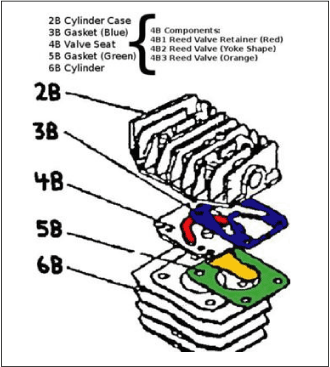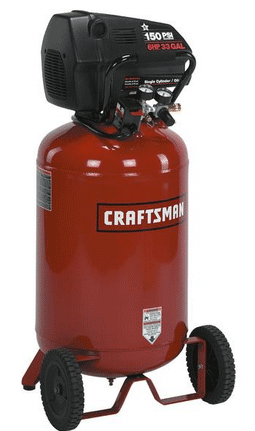A compressor reed valve failure is a common complaint sent in by people that have an air compressor that continues to run, but that will not build air pressure.
This page will provide you with how you can fix the reed valve failure, useful YouTube demonstrations on removing and replacing it, as well as existing reader questions and responses.
Table of Contents
- Fixing an Air Compressor Reed Valve Failure
- Useful Reed Valve Replacement Demonstrations
- FAQs (Frequently Asked Questions)
- Additional Troubleshooting Pages
- Reader Questions and Responses
Fixing an Air Compressor Reed Valve Failure
On behalf of all of us, our thanks to Jason Antonacci of North Augusta, SC for sending in a post and a diagram along with it, addressing the issue of air compressor reed valve failure. The diagram (shown below) is from the manual for Jason’s compressor.
The concept will apply to any compressor that uses some sort of reed valve setup for intake and high pressure air compressor valves.
Here is Jason’s drawing, his questions, and my response.

I have an air compressor that recently stopped building pressure beyond 40 psi. After reviewing your troubleshooting steps and documentation I had hope that the compressor could be rehabilitated. Thank you for your site, it has been an invaluable resource.
On disassembly I discovered the top, yoke shaped reed had failed: snapping in the middle. The bottom, tongue shaped reed is OK. If I can locate reasonably priced replacement parts, I’ll rebuild.
This brings me to my question. All gaskets appear to be a fibrous material (cardboard?) sandwiched between adhesive material. Not all of the gasket came off cleanly, so bits are stuck here and there on both surfaces.
What is the suggested method for re-finishing these surfaces for a new gasket? I was thinking a wire brush attachment on my drill. Do I need to be concerned about debris in the cylinder and if so how can I prevent/remove it? Lastly, what kind of lubrication?
Apparently this reed valve design is prone to failure based on the number of similar complaints. Maybe I’ll build a Franken-compressor, mounting the 5hp motor w/ a belt driven compressor of another make?
Response:
Thank you both for the compliment on my website, and for the photo/sketch of your compressor head.
Reed valve failure is a common complaint about many of the lower cost, DIY type air compressors on the market.
I would be hesitant about wire brushing the surfaces due to the potential for damage to the metal, and consequential difficulties in re-sealing. If you proceed in so doing, work slowly and carefully so that the metal isn’t scratched.
Consider using a liquid/cream cleaner like “Goo Gone”, or similar, that will dissolve adhesives and sealants. Read the directions and use them with care, please.
I would very much be concerned about getting debris into the cylinder. Before you cover it with clear plastic or the like, and/or before you reassembled it, blow it out with compressed air (difficult when your compressor is disassembled, I know) to ensure that there is no debris in there to possibly scratch the cylinder surface or damage the seals.
Others have manufactured their own compressor reed valves out of paint scraper blades. See the sitemap page for a link to those directions.
If you’re looking to Make Your Own Air Compressor Reed Valve then please visit our guide! Otherwise, continue scrolling down this page for useful reed valve replacement demonstrations.
Useful Reed Valve Replacement Demonstrations
I have picked out a couple useful youtube demonstrations on how to go about removing and replacing your air compressor reed valves.
FAQs (Frequently Asked Questions)
If a compressor reed valve goes bad, the compressor will not build pressure as the air is likely to escape through the intake/inlet rather than out the cylinder through the discharge/outlet.
The symptoms of bad reed valves are that the compressor will struggle to build pressure past a certain point or it will not build any pressure at all. It is therefore imperative to check the reed valve plate if you
Additional Troubleshooting Pages
Air Compressor Types Troubleshooting
- Centrifugal Air Compressor Troubleshooting
- Rotary Vane Air Compressor Troubleshooting
- Rotary Screw Air Compressor Troubleshooting
- Reciprocating Air Compressor Troubleshooting
- Scroll Air Compressor Troubleshooting
Air Compressor Part Specific Troubleshooting
- Air Compressor Troubleshooting, Solutions, Common Problems & Causes
- Air Compressor Check Valve Troubleshooting
- Air Compressor Electrical Troubleshooting
- Air Compressor Pressure Regulator Troubleshooting
- Air Compressor Pressure Switch Troubleshooting
- Air Compressor Smells Like It’s Burning? Troubleshooting Compressor Burning Smell
Reader Questions and Responses
Repairing / Replacing a compressor cylinder head.
Question:
by Bob
(Herndon VA)
I have an older Sears home-type compressor (2HP 7-8 gal tank) It wasn’t operating properly and I found a broken reed valve on the pressure side of the head.

It appears to have been riveted in and therefore not an easy home fix. New replacement heads seem not to come as an assembly, so even if I bought one I would still have the riveting problem. Is there a source for used parts Suggestions?
Response:
Hi Bob, and welcome to you and others from Virginia.
The downside of buying “house brand” DIY compressors is that they don’t normally lend themselves to repair.
Check with the store and ask them who repairs their compressors under warranty, and then ask those folks.
f the valves are riveted, it’s possible they are not designed to be replaced… a throwaway in other words. I expect you can drill out the rivets, but yup, a lot of work.
Used parts? Possibly. Maybe a visitor can comment on that.
If you have any questions regarding air compressor reed valve failure then please leave a comment below, with a photo if applicable so that someone can help you!
